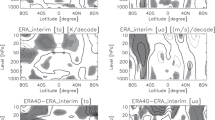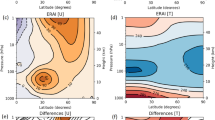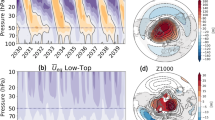Abstract
A parallel comparison is made of the circulation climatology and the leading oscillation mode of the northern winter stratosphere among six reanalysis products and 24 CMIP5 (Coupled Model Intercomparison Project Phase 5) models. The results reveal that the NCEP/NCAR, NECP/DOE, ERA40, ERA-Interim and JRA25 reanalyses are quite consistent in describing the climatology and annual cycle of the stratospheric circulation. The 20CR reanalysis, however, exhibits a remarkable “cold pole” bias accompanied by a much stronger stratospheric polar jet, similar as in some CMIP5 models. Compared to the 1–2 month seasonal drift in most coupled general circulation models (GCMs), the seasonal cycle of the stratospheric zonal wind in most earth system models (ESMs) agrees very well with reanalysis. Similar to the climatology, the amplitude of Polar Vortex Oscillation (PVO) events also varies among CMIP5 models. The PVO amplitude in most GCMs is relatively weaker than in reanalysis, while that in most of the ESMs is more realistic. In relation to the “cold pole” bias and the weaker oscillation in some CMIP5 GCMs, the frequency of PVO events is significantly underestimated by CMIP5 GCMs; while in most ESMs, it is comparable to that in reanalysis. The PVO events in reanalysis (except in 20CR) mainly occur from mid-winter to early spring (January–March); but in some of the CMIP5 models, a 1–2 month delay exists, especially in most of the CMIP5 GCMs. The long-term trend of the PVO time series does not correspond to long-term changes in the frequency of PVO events in most of the CMIP5 models.
Similar content being viewed by others
References
Baldwin, M. P., and T. J. Dunkerton, 1999: Propagation of the Arctic Oscillation from the stratosphere to the troposphere. J. Geophys. Res., 104, 30937–30946, doi:10.1029/1999jd900445.
Baldwin, M. P., and T. J. Dunkerton, 2001: Stratospheric harbingers of anomalous weather regimes. Science, 294, 581–584.
Bao, Q., and Coauthors, 2013: The Flexible Global Ocean-Atmosphere-Land system model, Spectral Version 2: FGOALS-s2. Adv. Atmos. Sci., 30, 561–576, doi: 10.1007/s00376-012-2113-9.
Bentsen, M., and Coauthors, 2013: The Norwegian Earth System Model, NorESM1-M-Part 1: Description and basic evaluation of the physical climate. Geoscientific Model Development, 6, 687–720.
Cai, M., 2003: Potential vorticity intrusion index and climate variability of surface temperature. Geophys. Res. Lett., 30, 1119, doi:10.1029/2002GL015926.
Cai, M., and R. C. Ren, 2006: 40–70 day meridional propagation of global circulation anomalies. Geophys. Res. Lett., 33, L06818, doi:10.1029/2005GL025024.
Cai, M., and R. C. Ren, 2007: Meridional and downward propagation of atmospheric circulation anomalies. Part I: Northern Hemisphere cold season variability. J. Atmos. Sci., 64, 1880–1901.
Charlton, A. J., and Coauthors, 2007: A new look at stratospheric sudden warmings. Part II: Evaluation of numerical model simulations. J. Climate, 20, 470–488.
Collins, M., S. F. B. Tett, and C. Cooper, 2001: The internal climate variability of HadCM3, a version of the Hadley Centre coupled model without flux adjustments. Climate Dyn., 17, 61–81.
Compo, G. P., and Coauthors, 2011: The twentieth century reanalysis project. Quart. J. Roy. Meteor. Soc., 137, 1–28.
Dee, D. P., and Coauthors, 2011: The ERA-Interim reanalysis: configuration and performance of the data assimilation system. Quart. J. Roy. Meteor. Soc., 137, 553–597.
Donner, L. J., and Coauthors, 2011: The dynamical core, physical parameterizations, and basic simulation characteristics of the atmospheric component AM3 of the GFDL Global Coupled Model CM3. J. Climate, 24, 3484–3519.
Dufresne, J. L., and Coauthors, 2013: Climate change projections using the IPSL-CM5 Earth System Model: from CMIP3 to CMIP5. Climate Dyn., 40, 2123–2165.
Eyring, V., T. G. Shepherd, and D. W. Waugh, 2010: SPARC report on the evaluation of chemistry-climate models. SPARC report No. 5, WCRP-132, WMO/TD-No. 1526. [Available online at http://www.atmosp.physics.utoronto.ca/SPARC.]
Gent, P. R., and Coauthors, 2011: The Community Climate System Model Version 4. J. Climate, 24, 4973–4991.
Giorgetta, M. A., and Coauthors, 2013: Climate and carbon cycle changes from 1850 to 2100 in MPI-ESM simulations for the Coupled Model Intercomparison Project phase 5. Journal of Advances in Modeling Earth Systems, 5, 572–597.
Kalnay, E., and Coauthors, 1996: The NCEP/NCAR 40-year reanalysis project. Bull. Amer. Meteor. Soc., 77, 437–471.
Kanamitsu, M., W. Ebisuzaki, J. Woollen, S.-K. Yang, J. J. Hnilo, M. Fiorino, and G. L. Potter, 2002: NCEP-DOE AMIP-II Reanalysis (R-2). Bull. Amer. Meteor. Soc., 83, 1631–1643.
Kim, D., and Coauthors, 2012: The tropical subseasonal variability simulated in the NASA GISS general circulation model. J. Climate, 25, 4641–4659.
Kodera, K., K. Yamazaki, M. Chiba, and K. Shibata, 1990: Downward propagation of upper stratospheric mean zonal wind perturbation to the troposphere. Geophys. Res. Lett., 17, 1263–1266, doi: 10.1029/Gl017i009p01263.
Langematz, U., M. Kunze, K. Krüger, K. Labitzke, and G. L. Roff, 2003: Thermal and dynamical changes of the stratosphere since 1979 and their link to ozone and CO2 changes. J. Geophys. Res., 108(D1), 4027, doi:10.1029/2002JD002069.
Li, L. J., and Coauthors, 2013: The Flexible Global Ocean-Atmosphere-Land system model, Grid-point Version 2: FGOALS-g2. Adv. Atmos. Sci., 30, 543–560, doi: 10.1007/s00376-012-2140-6.
Liu, Y. Z., R. C. Ren, and B. He, 2012: Comparison of SAMIL and BCC AGCM simulations of the polar vortex oscillation in the northern hemisphere winter. Chinese J. Atmos. Sci., 36, 1191–1206. (in Chinese)
Manzini, E., B. Steil, C. Bruhl, M. A. Giorgetta, and K. Kruger, 2003: A new interactive chemistry-climate model: 2. Sensitivity of the middle atmosphere to ozone depletion and increase in greenhouse gases and implications for recent stratospheric cooling. J. Geophys. Res., 108, 4429, doi:10.1029/2002JD002977.
Marsh, D. R., M. J. Mills, D. E. Kinnison, J. F. Lamarque, N. Calvo, and L.M. Polvani, 2013: Climate change from 1850 to 2005 simulated in CESM1(WACCM). J. Climate, 26, 7372–7391.
Onogi, K., and Coauthors, 2007: The JRA-25 reanalysis. J. Meteor. Soc. Japan, 85, 369–432.
Pawson, S., and Coauthors, 2000: The GCM-Reality Intercomparison Project for SPARC (GRIPS): Scientific issues and initial results. Bull. Amer. Meteor. Soc., 81, 781–796.
Ramaswamy, V., M. D. Schwarzkopf, W. J. Randel, B. D. Santer, B. J. Soden, and G. L. Stenchikov, 2006: Anthropogenic and natural influences in the evolution of lower stratospheric cooling. Science, 311, 1138–1141.
Ramaswamy, V., and Coauthors, 2001: Stratospheric temperature trends: Observations and model simulations. Rev. Geophys., 39, 71–122, doi:10.1029/1999rg000065.
Randel, W. J., F. Wu, J. M. Russell, and J. Waters, 1999: Spacetime patterns of trends in stratospheric constituents derived from UARS measurements. J. Geophys. Res., 104, 3711–3727, doi:10.1029/1998jd100044.
Ren, R. C., and M. Cai, 2006: Polar vortex oscillation viewed in an isentropic potential vorticity coordinate. Adv. Atmos. Sci., 23, 884–900, doi: 10.1007/s00376-006-0884-6.
Ren, R. C., and M. Cai, 2007: Meridional and vertical out-of-phase relationships of temperature anomalies associated with the Northern Annular Mode variability. Geophys. Res. Lett., 34, L07704, doi:10.1029/2006GL028729.
Ren, R. C., and Y. Yang, 2012: Changes in winter stratospheric cir culation in CMIP5 scenarios simulated by the climate system model FGOALS-s2. Adv. Atmos. Sci., 29, 1374–1389, doi: 10.1007/s00376-012-1184-y.
Ren, R. C., G. X. Wu, C. Ming, and J. J. Yu, 2009: Winter season stratospheric circulation in the SAMIL/LASG general circulation model. Adv. Atmos. Sci., 26, 451–464, doi: 10.1007/s00376-009-0451-z.
Rotstayn, L. D., M. A. Collier, M. R. Dix, F. Yan, H. B. Gordon, S. P. O’farrell, I. N. Smith, and J. Syktus, 2009: Improved simulation of Australian climate and ENSO-related rainfall variability in a global climate model with an interactive aerosol treatment. Int. J. Climatol., 30, 1067–1088.
Taylor, K. E., R. J. Stouffer, and G. A. Meehl, 2012: An overview of CMIP5 and the experiment design. Bull. Amer. Meteor. Soc., 93, 485–498.
Thompson, D. W. J., and J. M. Wallace, 1998: The Arctic Oscillation signature in the wintertime geopotential height and temperature fields. Geophys. Res. Lett., 25, 1297–1300, doi: 10.1029/98gl00950.
Thompson, D. W. J., M. P. Baldwin, and J. M. Wallace, 2002: Stratospheric connection to Northern Hemisphere wintertime weather: Implications for prediction. J. Climate, 15, 1421–1428.
Uppala, S. M., and Coauthors, 2005: The ERA-40 re-analysis. Quart. J. Roy. Meteor. Soc., 131, 2961–3012.
Voldoire, A., and Coauthors, 2013: The CNRM-CM5.1 global climate model: Description and basic evaluation. Climate Dyn., 40, 2091–2121.
Volodin, E. M., N. A. Dianskii, and A. V. Gusev, 2010: Simulating present-day climate with the INMCM4.0 coupled model of the atmospheric and oceanic general circulations. Izvestiya, Atmospheric and Oceanic Physics, 46, 414–431.
Watanabe, M., and Coauthors, 2010: Improved climate simulation by MIROC5: Mean states, variability, and climate sensitivity. J. Climate, 23, 6312–335.
Wu, T. W., and Coauthors, 2013: Global carbon budgets simulated by the Beijing Climate Center Climate System Model for the last century. J. Geophys. Res., 118, 4326–4347, doi: 10.1002/jgrd.50320.
Xin, X., T. Wu, and J. Zhang, 2013: Introduction of CMIP5 experiments carried out with the climate system models of Beijing Climate Center. Advances in Climate Change Research, 4, 41–9.
Yukimoto, S., and Coauthors, 2012: A new global climate model of the meteorological research institute: MRI-CGCM3, model description and basic performance. J. Meteor. Soc. Japan, 90A, 23–64.
Author information
Authors and Affiliations
Corresponding author
Rights and permissions
About this article
Cite this article
Rao, J., Ren, R. & Yang, Y. Parallel comparison of the northern winter stratospheric circulation in reanalysis and in CMIP5 models. Adv. Atmos. Sci. 32, 952–966 (2015). https://doi.org/10.1007/s00376-014-4192-2
Received:
Revised:
Accepted:
Published:
Issue Date:
DOI: https://doi.org/10.1007/s00376-014-4192-2




